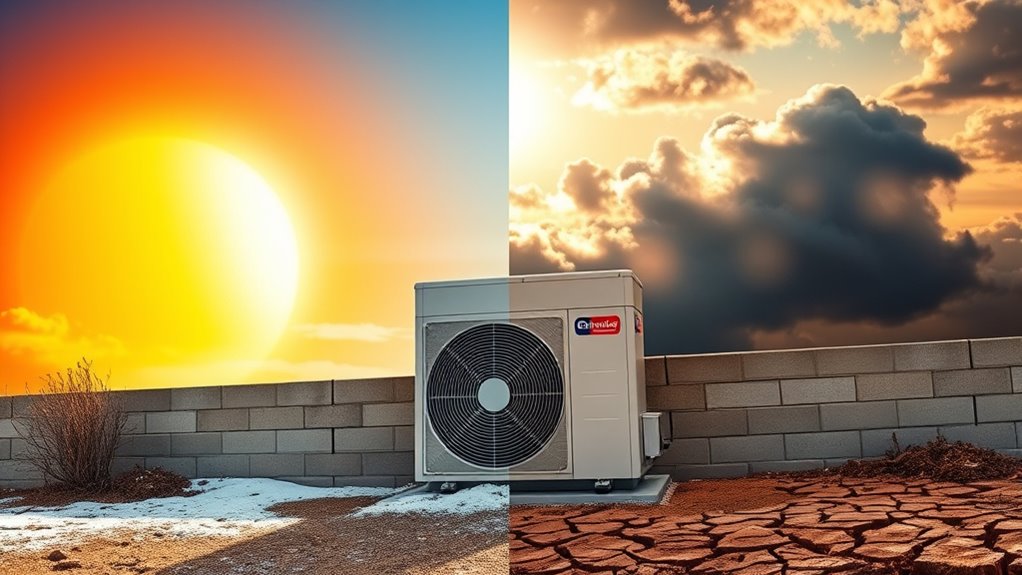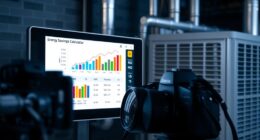Your climate greatly impacts your heat pump’s operating costs. In colder weather, your system works harder to extract heat, increasing energy use, wear and tear, and your bills. Mild climates improve efficiency and reduce expenses, while extreme cold can cause higher maintenance needs. Solar power and proper maintenance can help cut costs, but if you want to understand how your environment influences your savings and system longevity, keep exploring these factors in more detail.
Key Takeaways
- Colder climates increase heat pump workload, raising energy consumption and operational costs.
- Mild climates allow more efficient heat pump operation, lowering energy bills and wear.
- Extreme cold causes more system strain and maintenance, raising long-term expenses.
- Solar efficiency varies with sunlight availability, influencing overall energy savings and costs.
- Regular maintenance in harsh climates prevents damage, ensuring optimal performance and cost savings.

Climate considerably influences how much it costs to operate a heat pump. When temperatures drop, your system has to work harder to maintain a comfortable indoor environment, which can markedly increase energy consumption and, consequently, your bills. Conversely, milder climates allow your heat pump to operate more efficiently, saving you money over time. But beyond external temperatures, other factors like solar efficiency and maintenance frequency also play vital roles in determining your ongoing costs.
Climate impacts heat pump costs, with colder weather increasing energy use and milder climates boosting efficiency.
In colder climates, your heat pump faces the challenge of extracting heat from the freezing outdoor air. This process becomes less efficient as temperatures plummet, meaning your system needs to run longer and more often to keep your home warm. This increased workload leads to higher energy bills and more wear and tear. On the other hand, in warmer regions, your heat pump works primarily for cooling, and since outdoor temperatures stay within a manageable range, it operates more efficiently. That means fewer energy expenses and less strain on your system.
Solar efficiency is another factor that influences operating costs. If your home is well-positioned for solar gain, you might benefit from the sun’s energy to offset some of your heat pump’s load. During sunny days, solar panels can generate electricity that reduces the amount your heat pump needs from the grid, especially in cooling seasons. Even in heating seasons, passive solar heating can diminish the demand on your heat pump, lowering your energy bills. However, in climates with limited sunlight or shorter days, solar efficiency drops, making it less effective at reducing operating costs. So, understanding how much sunlight your location receives helps you gauge potential savings and adjust your energy use accordingly.
Maintenance frequency also impacts how much your heat pump costs you in the long run. Regular maintenance ensures your system runs smoothly and efficiently, especially in extreme climates where stress on the equipment is higher. Neglecting routine checks and filter replacements can cause your system to work harder, consume more energy, and wear out faster. In harsher climates, you’ll need to schedule maintenance more frequently to prevent breakdowns and maintain ideal efficiency. This proactive approach can save you money by extending the life of your heat pump and keeping energy costs in check. Conversely, skimping on maintenance might lead to costly repairs and higher energy consumption, negating any initial savings.
Ultimately, your climate’s severity, solar efficiency, and maintenance habits all influence your heat pump’s operating costs. Recognizing these factors helps you make smarter choices—whether that’s investing in better insulation, optimizing solar setups, or sticking to a regular maintenance schedule—to keep your energy bills manageable regardless of the weather outside.
Frequently Asked Questions
How Does Humidity Influence Heat Pump Efficiency?
Humidity effects your heat pump efficiency by making it work harder in humid conditions. When humidity is high, the dew point rises, leading to increased moisture in the air. Your heat pump must then dehumidify the air, which consumes more energy and reduces efficiency. You’ll notice higher energy bills and potentially less effective heating or cooling. Keeping humidity levels balanced can help your heat pump operate more efficiently and save you money.
What Climate Factors Cause the Most Wear on Heat Pumps?
You might not realize it, but harsh winter conditions can accelerate heat pump wear. Cold temperatures increase corrosion risk, especially when combined with moisture, while snow accumulation can block outdoor units, reducing efficiency and causing strain. These climate factors, like frequent freeze-thaw cycles and salt exposure, wear down components faster, making it vital to perform regular maintenance and guarantee proper protection to extend your heat pump’s lifespan.
Do Regional Energy Prices Affect Operating Costs?
Regional energy prices, including energy tariffs, definitely affect your heat pump’s operating costs. Higher tariffs in certain areas mean you’ll pay more for electricity, increasing overall expenses. Regional variations in electricity rates can make your heat pump more or less cost-effective depending on where you live. Keep in mind that choosing a location with lower energy tariffs can help you save money on operating costs over time.
How Do Seasonal Temperature Fluctuations Impact Performance?
Seasonal temperature fluctuations directly impact your heat pump’s performance, making it work harder during colder months and less during warmer periods. This variation affects efficiency and operating costs. Solar variability can influence outdoor temperatures, while air quality changes may affect heat exchange. You might notice increased energy use during extreme cold or poor air quality days, which can raise your heating costs and impact overall system effectiveness.
Are There Specific Climate Conditions That Extend Heat Pump Lifespan?
Did you know that proper climate conditions can extend a heat pump’s lifespan by up to 50%? You’ll want to follow recommended maintenance schedules and make certain installation requirements are met, especially in milder climates. Extreme cold or heat can strain components, but with regular upkeep and suitable installation, your heat pump can perform efficiently and last longer, saving you money and hassle down the line.
Conclusion
Just like a garden depends on sunlight and rain, your heat pump’s costs depend on the climate. When temperatures swing, your system works harder, much like a traveler battling changing weather. By understanding how climate impacts your heat pump, you can better prepare and optimize its efficiency. Think of it as tuning a musical instrument—you’ll enjoy a smoother, more cost-effective performance no matter the weather’s mood.








